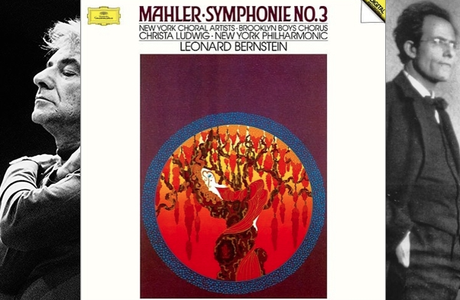by Paul J. Pelkonen

Art for the original release of Mahler's Symphony No. 3 by Erte.
Of the wild and unpredictable early symphonies of Gustav Mahler, it could be argued that the composer’s Third, heard here as played by Leonard Bernstein and the New York Philharmonic in 1987, is the wildest. It is certainly the longest, a sprawling six-movement work whose outer movements are each longer than most Beethoven compositions. The Third charts a cosmological course, starting with the the upthrust and upheaval of primeval mountain ranges and culminating in a slow finale that looks the Almighty square in the eye.Bernstein’s relationship with the New York Philharmonic jump-started in 1943 when the conductor stepped in to substitute for Bruno Walter at Carnegie Hall. He became its music director in 1957 and held the post for twelve years. During that run, the Philharmonic moved from its home at Carnegie to the newly constructed Philharmonic Hall, and the conductor began to record his first complete cycle of the Mahler symphonies for the Columbia label, now Sony Classical. (This Third is from the later cycle for Deutsche Grammophon.) It is more extreme in its approach to tempo and expression as the conductor wrings every last drop of emotion from the players.
The massive opening movement is in two sections. A stentorian theme in the brass announces the main subject, a rousing call that Mahler compared to the awakening of the Greek nature god Pan. “Pan” was also one of Mahler’s three proposed (and rejected) titles for the Third, referring to the horned god as well as the word's other meaning: encompassing all of nature. That brass theme is answered by the muffled muttering of basses and thumps on a gran casa, the first indication of the wild quasi-military procession that will make up the bulk of the movement. The "Pan" theme (for want of a better name) comes back again and again, and is answered by a theme in the violins that is taken up by the horns and forms the main subject of the movement.
These solemn ideas are eventually supplanted by a raucous march in the woodwinds and trumpets., that starts from a great distance but eventually stomps right up into the listener’s space with the force of a rapid change of seasons. One can imagine the rocky mountains quickly adorned with flowers and meadows, and the celebrating flutes and piccolos bursting from the treetops likes flocks of birds. This vast celebration grinds to a shattering, climactic chord, and the solemn first theme appears, before allowing the party to march on into a bright major close. This performance is faster than most, never lumbering as Bernstein exhorts the players to new heights of bacchanal.
The next two movements start gently. First comes the lilting waltz that Mahler meant to evoke flowers dancing in a summer breeze, and then a long and mincing scherzo that evokes the animals of the forest. This movement, whose progress is repeatedly interrupted by a serene string figure and a gentle melody played offstage on a post-horn, is the first indication that Mahler is composing here with the utmost of serious intent. Bernstein treats this figure slowly and with reverence, spreading the tempo as far as it can go until it answered by the onstage horns. The dance is interrupted by a sudden appearance of the marching ensemble from the first movement, which brings the movement to a clattering close.
The heaving, cosmic breath of the first movement opens the fourth, which is a very slow solo for mezzo-soprano Christa Ludwig. She sings "O mensch, gib acht!", the "Midnight Song" from Friedrich Nietzche's Also Sprach Zarathustra. She sings of deep sleep, deeper misery and the suffering of men, and of the longing for a state of joy. The horns sing underneath the carpet of strings, and a woodwind solo begins to resolve some of the promises of the first movement. This is the counterpart to the "O Rosen rot!" movement of the Second, a cosmic table-setter for the exploration of the empyrean that is to come. The next movement, featuring the Brooklyn Boys Chorus and the women of the New York Choral Artists, is, for the most part light-footed and joyful. It a Wunderhorn song with angels ringing bells and cherubs celebrating. It is a total contrast to the spare atheism of Nietzche's text.
So, how to resolve this conflict between heaven and earth? Mahler's answer is a proper slow movement for orchestra, taken by Bernstein at the broadest possible tempo. The opening chords unfold with a deliberate majesty that sounds song-like, not sluggish. This profound finale is almost as long as its brother movement that opened the symphony, but here the orchestra is all about singing out in a muted hymn of praise to nature that owes something to Robert Schumann. The movement culminates in chorales of brass, pealing out softly as if Mahler is opening up the gates to something beyond the listener's ability to comprehend. Bernstein is just the conduit, the celebrant leading this ceremony its resolve. When that does come, in the person of the full chorale of brass, percussion and orchestra one is glad for the tonal resolution, although vaguely resentful at being woken from Mahler's glorious musical dream.
Support independent arts journalism! Be a part of the blog that writes for quality music coverage in New York City and elsewhere! Enable more reviews! Visit our Patreon! A monthly support slot is $5 and I will put your money where my mouth is.

